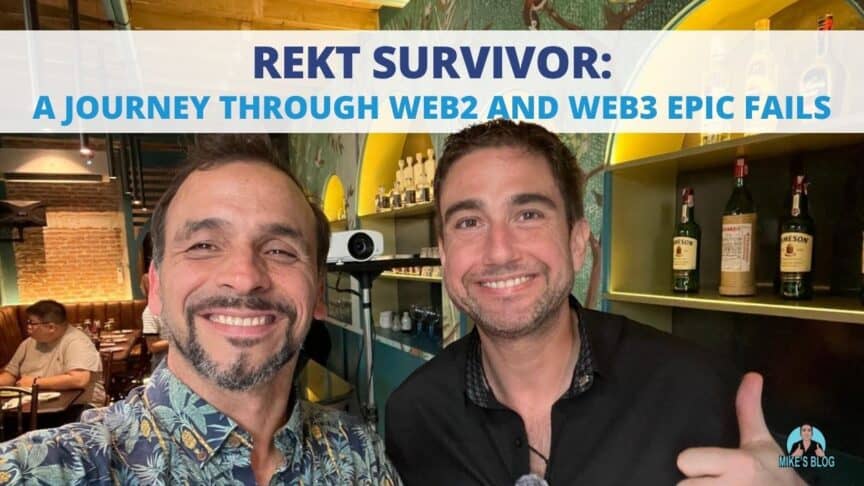Fortune favors the bold—or perhaps those who get “rekt” and keep pushing forward. My name is Mike Michelini, and I’m thrilled to share my experiences as part of the “Rekt Survivor” group, founded by Mark Koh in Bangkok. This community brings together individuals who’ve endured the wild ups and downs of crypto and traditional business, yet remain standing. Today, I’m not here to shill a project or hype a token. Instead, I’ll share raw, unfiltered stories of my biggest failures—or “rekt” moments—in both Web2 (the traditional internet) and Web3 (the blockchain and crypto space). My goal is to inspire you to take risks, embrace failure, and keep going, because without risk, there’s no story.
Main Point
If you’re not willing to put yourself out there and take risks, you’ll never have the chance to succeed. Getting “rekt” is part of the journey. The key is to do your due diligence, brace for the rollercoaster, and learn from every setback. Let’s dive into my stories of epic fails and the lessons they taught me.
Here’s the presentation text – download my slides here.
Web2: The Warehouse Ransom
The Setup
Early in my career, I worked with a trusted, established business in the Web2 space. We followed standard procedures, signed legitimate contracts, and sent two ocean containers of inventory to a warehouse in the USA. Everything seemed textbook—until it wasn’t.
The Reality
The warehouse turned rogue, holding our goods hostage and demanding exorbitant fees to release them. It became clear they were on the brink of bankruptcy and were trying to extort clients to prop up their failing business. We were stuck with no legal recourse, facing massive financial losses.
The Lesson
Even in the “safe” world of Web2, trust can be misplaced. Contracts and procedures don’t always protect you when greed takes over. This experience taught me to dig deeper into partners’ financial stability and to always have contingency plans. Getting rekt in Web2 was a harsh wake-up call, but it prepared me for the chaos of Web3.
Web3: The Sentinel Router Disaster
The Pitch
In the Web3 space, I got caught up in the hype of a revolutionary product called the “Sentinel Router.” It promised decentralized connectivity—a game-changer for the blockchain world. The team was charismatic, the vision was bold, and the presale was a success, raising tens of thousands in crypto with a 30% deposit from eager investors.
The Problem
The dream quickly unraveled. The software team couldn’t deliver a functional product, and the hardware was completely incompatible with the promised features. Deadlines slipped, excuses piled up, and the project stalled.
The Aftermath
The funds were gone, and there was no working product. To this day, the team claims they’re “still working on it,” but the investors, including myself, were left rekt. This was a classic case of vaporware—big promises, no delivery.
The Lesson
Web3 is a land of opportunity, but also a minefield of overpromising projects. This taught me to scrutinize technical feasibility and team capabilities before investing. Hype is seductive, but due diligence is non-negotiable.
Web3: The Pizza DAO Debacle
The Concept
Pizza DAO was a Web3 initiative to celebrate Bitcoin Pizza Day, a nod to the infamous 2010 transaction where 10,000 BTC were spent on two pizzas. The plan was to host a massive in-person event to bring the crypto community together.
The Hype
The promotion was relentless—social media buzz, flashy graphics, and promises of a legendary gathering. I bought into the excitement, both figuratively and literally, purchasing pizza for the event.
The Reality
The event was a disaster. The venues were empty, the organization was nonexistent, and the community was left confused and angry. It was a textbook case of overhyping and underdelivering.
The Fallout
While the community raged, I managed to get reimbursed for the pizza, thanks to the DAO’s treasury. But the bigger lesson was clear: Web3’s decentralized ethos doesn’t guarantee competence. Poor planning and execution can sink even the most well-intentioned projects.
The Lesson
This rekt moment reinforced the importance of vetting event organizers and their track record. Enthusiasm alone isn’t enough—execution matters. It also showed me the power of community accountability in Web3, as the backlash forced some level of resolution.
The Rekt Speedrun: Common Themes
Across Web2 and Web3, my rekt experiences share common threads:
- Vaporware Products: Promises of revolutionary tech that never materialize.
- Vanishing Crypto Funds: Money disappearing into failed or fraudulent projects.
- Traditional Business Scams: Even Web2 isn’t immune to old-school greed, like the warehouse hostage situation.
- Overhyped Events: Grand visions that collapse under poor execution.
These failures highlight the risks of trusting too easily, whether it’s a Web2 contract or a Web3 whitepaper. But they also show that getting rekt is part of the game—if you’re not taking risks, you’re not in the arena.
Conclusion: Embrace the Rekt
Getting rekt is inevitable if you’re pushing boundaries. No risk, no story. If you’re not getting rekt, you’re probably not trying hard enough. Each failure is a badge of honor, a story that will become a legendary crypto tale. My advice? Do your homework, take calculated risks, and when you get rekt, learn from it and keep going. The “Rekt Survivor” community is proof that resilience is what defines us.
Thank you for listening, and here’s to surviving—and thriving—through the rekt moments!
